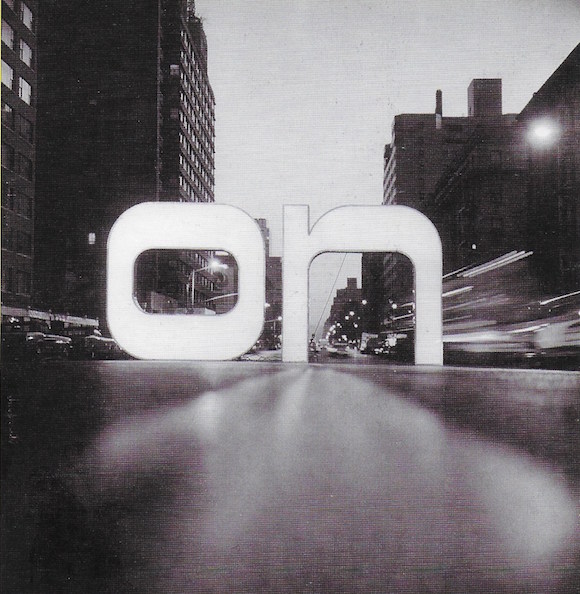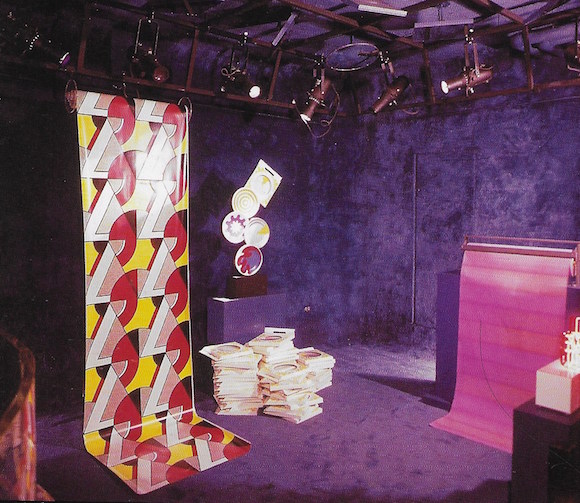For Jim Walrod – ‘Decoration is the danger, function is the idea’: The On 1st experiment in conceptual art retailing
** This post is dedicated to the New York design thinker and doer Jim Walrod, who has passed away. Just a couple of weeks ago I mentioned my intention to post about On 1st to Jim over dinner. Of course, he knew about the store but was excited to see what fresh info I might have turned up. I’ll write about Jim when I have collected my thoughts; wherever he is, I am sure Jim will join us all in the necessary proclamation: Fuck Trump**

//At the entrance to 1159 1st Avenue at 63rd was Sven Lukin’s two-tonne illuminated sign. Photo: Bert Stern//

//On 1st interior including displays of Roy Lichtenstein wallpaper and Gerald Laing plates. Photo: Bert Stern//
In conversation this summer, British artist Duggie Fields revealed to me that, during a sojourn in the US in 1968, he had been in line to work at photographer Bert Stern’s “architecturally mind-blowing” art store/publishing house On 1st in Manhattan’s east side.

//New York, November 18, 1968. Paul Gorman Archive//

//Opening spread of Julie Baumgold’s five-page feature. Paul Gorman Archive//
A return to London – where Fields reconnected with his friend, Pink Floyd’s Syd Barrett, and took up occupancy of the Earl’s Court where he resides to this day – worked against him taking the job at On 1st, which sold fashion and homewares in small editions by contemporary artists including Roy Lichtenstein, Gerald Laing, Billy Apple, James Lee Byars, Sven Lukin and Stern himself (he provided Marilyn Monroe print scarves in an edition of 20 at $30 each).
Even though it was only open for a matter of months at 1159 1st Avenue at 63rd Street, On 1st had quite an impact; interior shots show a space that was more art environment than retail outlet.

//Detail: Giant number puzzle by Isadore Seltzer. Paul Gorman Archive//

//Detail: Plastic lamp by Billy Apple. Paul Gorman Archive//

//Detail: Model with On 1st official scarf by Sven Lukin. Paul Gorman Archive//
In a five-page cover preview in New York magazine art directors Walter Bernard and Milton Glaser made the most of the subject matter, featuring photographs of Lukin’s illuminated sign/installation and models posing with scarves.
“Decoration is the danger, function is the idea,” Stern told journalist Julie Baumgold. “We protect our thing from becoming junky. That’s why we limit it. It’s not going to…Bloomingdales.”

//Second spread with (centre) Roy Lichtenstein wallpaper. Paul Gorman Archive//

//Detail: Gerald Laing paper plate with model holding parachute print scarf, also by Laing. Paul Gorman Archive//

//Detail: Another Laing plate with model holding James Lee Byars’ curious “Mask Or Underwear” garment. Paul Gorman Archive//
Bill Cunningham, then a reporter yet to make his name as the world’s leading street style photographer, wrote in the Chicago Tribune: “The hole in the “O” serves as what would usually be a display window; here television screens fill the space, occasionally playing the inside action for those too timid to go thru the “n,” and the door of black glass. This opens into a black-painted entrance hall-which in turn leads into the capsule-like gallery. The shop is entirely covered in royal blue carpeting, which runs along the floor, up the walls, and over the ceiling. It is not for the claustrophobic.”

//Page five of the feature included an image of silk screen scarf featuring one of Stern’s images of Marilyn Monroe. Paul Gorman Archive//

//Detail: Model Kediki in dress and satin trousers by Alice Pollock + Ossie Clark with belt by Kenneth Jay Lane. Paul Gorman Archive//
Cunningham’s full report and much more detail on this extraordinary outlet can be found at the Alden Projects site.
Read Todd Alden’s On 1st essay here.
